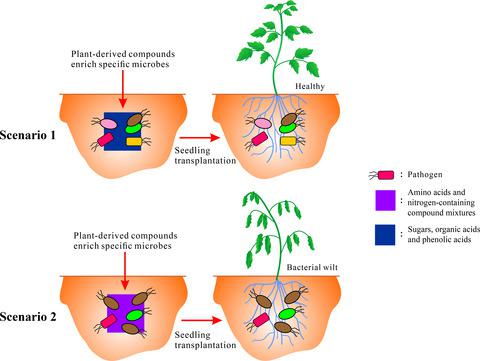当前位置:
X-MOL 学术
›
Funct. Ecol.
›
论文详情
Our official English website, www.x-mol.net, welcomes your
feedback! (Note: you will need to create a separate account there.)
Chemical structure predicts the effect of plant‐derived low molecular weight compounds on soil microbiome structure and pathogen suppression
Functional Ecology ( IF 4.6 ) Pub Date : 2020-07-31 , DOI: 10.1111/1365-2435.13624 Yian Gu 1, 2 , Xiaofang Wang 1 , Tianjie Yang 1 , Ville‐Petri Friman 1, 3 , Stefan Geisen 4, 5 , Zhong Wei 1 , Yangchun Xu 1 , Alexandre Jousset 1, 6 , Qirong Shen 1
Functional Ecology ( IF 4.6 ) Pub Date : 2020-07-31 , DOI: 10.1111/1365-2435.13624 Yian Gu 1, 2 , Xiaofang Wang 1 , Tianjie Yang 1 , Ville‐Petri Friman 1, 3 , Stefan Geisen 4, 5 , Zhong Wei 1 , Yangchun Xu 1 , Alexandre Jousset 1, 6 , Qirong Shen 1
Affiliation

|
1. Plant‐derived low molecular weight compounds play a crucial role in shaping soil microbiome functionality. While various compounds have been demonstrated to affect soil microbes, mout data are case‐specific and do not provide generalizable predictions on their effects. Here we show that the chemical structural affiliation of low molecular weight compounds typically secreted by plant roots – sugars, amino acids, organic acids and phenolic acids – can predictably affect microbiome diversity, composition and functioning in terms of plant disease suppression. 2. We amended soil with single or mixtures of representative compounds, mimicking carbon deposition by plants. We then assessed how different classes of compounds, or their combinations, affected microbiome composition and the protection of tomato plants from the soil‐borne Ralstonia solanacearum bacterial pathogen. 3. We found that chemical class predicted well the changes in microbiome composition and diversity. Organic and amino acids generally decreased the microbiome diversity compared to sugars and phenolic acids. These changes were also linked to disease incidence, with amino acids and nitrogen‐containing compound mixtures inducing more severe disease symptoms connected with a reduction in bacterial community diversity. 4. Together, our results demonstrate that low molecular weight compounds can predictably steer rhizosphere microbiome functioning providing guidelines to engineer microbiomes based on root exudation patterns by specific plant cultivars or crop regimes.
中文翻译:

化学结构预测植物来源的低分子量化合物对土壤微生物组结构和病原体抑制的影响
1. 植物来源的低分子量化合物在塑造土壤微生物组功能方面起着至关重要的作用。虽然各种化合物已被证明会影响土壤微生物,但 mout 数据是针对具体情况的,并不能对其影响提供可概括的预测。在这里,我们表明,通常由植物根部分泌的低分子量化合物(糖、氨基酸、有机酸和酚酸)的化学结构隶属关系可以在植物病害抑制方面对微生物组的多样性、组成和功能产生可预测的影响。2. 我们用代表性化合物的单一或混合物改良土壤,模拟植物的碳沉积。然后我们评估了不同类别的化合物或它们的组合,影响微生物组组成和保护番茄植物免受土壤传播的青枯病菌细菌病原体的侵害。3. 我们发现化学类别可以很好地预测微生物组组成和多样性的变化。与糖和酚酸相比,有机酸和氨基酸通常会降低微生物组的多样性。这些变化也与疾病发生率有关,氨基酸和含氮化合物混合物会导致更严重的疾病症状,同时细菌群落多样性的减少。4. 总之,我们的结果表明,低分子量化合物可以预测根际微生物组的功能,为基于特定植物栽培品种或作物制度的根系分泌模式设计微生物组提供指导。我们发现化学类别可以很好地预测微生物组组成和多样性的变化。与糖和酚酸相比,有机酸和氨基酸通常会降低微生物组的多样性。这些变化也与疾病发生率有关,氨基酸和含氮化合物混合物会导致更严重的疾病症状,同时细菌群落多样性的减少。4. 总之,我们的结果表明,低分子量化合物可以预测根际微生物组的功能,为基于特定植物栽培品种或作物制度的根系分泌模式设计微生物组提供指导。我们发现化学类别可以很好地预测微生物组组成和多样性的变化。与糖和酚酸相比,有机酸和氨基酸通常会降低微生物组的多样性。这些变化也与疾病发生率有关,氨基酸和含氮化合物混合物会导致更严重的疾病症状,同时细菌群落多样性的减少。4. 总之,我们的结果表明,低分子量化合物可以预测根际微生物组的功能,为基于特定植物栽培品种或作物制度的根系分泌模式设计微生物组提供指导。这些变化也与疾病发生率有关,氨基酸和含氮化合物混合物会导致更严重的疾病症状,同时细菌群落多样性的减少。4. 总之,我们的结果表明,低分子量化合物可以预测根际微生物组的功能,为基于特定植物栽培品种或作物制度的根系分泌模式设计微生物组提供指导。这些变化也与疾病发生率有关,氨基酸和含氮化合物混合物会导致更严重的疾病症状,同时细菌群落多样性的减少。4. 总之,我们的结果表明,低分子量化合物可以预测根际微生物组的功能,为基于特定植物栽培品种或作物制度的根系分泌模式设计微生物组提供指导。
更新日期:2020-07-31
中文翻译:

化学结构预测植物来源的低分子量化合物对土壤微生物组结构和病原体抑制的影响
1. 植物来源的低分子量化合物在塑造土壤微生物组功能方面起着至关重要的作用。虽然各种化合物已被证明会影响土壤微生物,但 mout 数据是针对具体情况的,并不能对其影响提供可概括的预测。在这里,我们表明,通常由植物根部分泌的低分子量化合物(糖、氨基酸、有机酸和酚酸)的化学结构隶属关系可以在植物病害抑制方面对微生物组的多样性、组成和功能产生可预测的影响。2. 我们用代表性化合物的单一或混合物改良土壤,模拟植物的碳沉积。然后我们评估了不同类别的化合物或它们的组合,影响微生物组组成和保护番茄植物免受土壤传播的青枯病菌细菌病原体的侵害。3. 我们发现化学类别可以很好地预测微生物组组成和多样性的变化。与糖和酚酸相比,有机酸和氨基酸通常会降低微生物组的多样性。这些变化也与疾病发生率有关,氨基酸和含氮化合物混合物会导致更严重的疾病症状,同时细菌群落多样性的减少。4. 总之,我们的结果表明,低分子量化合物可以预测根际微生物组的功能,为基于特定植物栽培品种或作物制度的根系分泌模式设计微生物组提供指导。我们发现化学类别可以很好地预测微生物组组成和多样性的变化。与糖和酚酸相比,有机酸和氨基酸通常会降低微生物组的多样性。这些变化也与疾病发生率有关,氨基酸和含氮化合物混合物会导致更严重的疾病症状,同时细菌群落多样性的减少。4. 总之,我们的结果表明,低分子量化合物可以预测根际微生物组的功能,为基于特定植物栽培品种或作物制度的根系分泌模式设计微生物组提供指导。我们发现化学类别可以很好地预测微生物组组成和多样性的变化。与糖和酚酸相比,有机酸和氨基酸通常会降低微生物组的多样性。这些变化也与疾病发生率有关,氨基酸和含氮化合物混合物会导致更严重的疾病症状,同时细菌群落多样性的减少。4. 总之,我们的结果表明,低分子量化合物可以预测根际微生物组的功能,为基于特定植物栽培品种或作物制度的根系分泌模式设计微生物组提供指导。这些变化也与疾病发生率有关,氨基酸和含氮化合物混合物会导致更严重的疾病症状,同时细菌群落多样性的减少。4. 总之,我们的结果表明,低分子量化合物可以预测根际微生物组的功能,为基于特定植物栽培品种或作物制度的根系分泌模式设计微生物组提供指导。这些变化也与疾病发生率有关,氨基酸和含氮化合物混合物会导致更严重的疾病症状,同时细菌群落多样性的减少。4. 总之,我们的结果表明,低分子量化合物可以预测根际微生物组的功能,为基于特定植物栽培品种或作物制度的根系分泌模式设计微生物组提供指导。











































 京公网安备 11010802027423号
京公网安备 11010802027423号